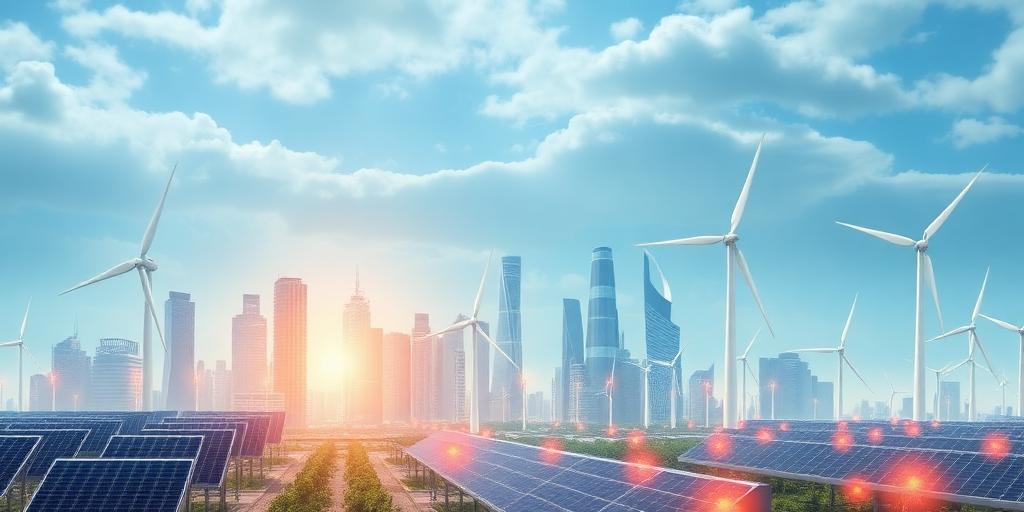Emerging Tech in Energy Innovation
The energy sector is undergoing a dramatic transformation, driven by the urgent need for sustainable and efficient solutions. Emerging technologies are at the forefront of this revolution, offering innovative ways to generate, store, and distribute energy. This post will explore some of the most promising technologies that are poised to reshape the energy landscape.
1. Advanced Materials for Solar Cells
Traditional silicon-based solar cells have limitations in terms of efficiency and cost. New materials like perovskites, quantum dots, and organic polymers are being developed to enhance solar cell performance. Perovskites, for example, offer high efficiency and can be manufactured at a lower cost than silicon. Quantum dots, with their tunable electronic properties, allow for the creation of highly efficient and flexible solar cells. Organic polymers are lightweight and can be printed on various surfaces, opening up new possibilities for solar energy applications.
2. Smart Grids and IoT
Smart grids utilize advanced sensors, data analytics, and communication technologies to optimize energy distribution and consumption. The Internet of Things (IoT) plays a crucial role in enabling smart grids by connecting various devices and systems, such as smart meters, energy storage units, and renewable energy sources. Smart grids can improve grid reliability, reduce energy waste, and facilitate the integration of distributed energy resources, such as rooftop solar panels and electric vehicles.
3. Energy Storage Technologies
Energy storage is critical for addressing the intermittency of renewable energy sources like solar and wind. Lithium-ion batteries are currently the dominant energy storage technology, but other promising technologies are emerging. Flow batteries, which store energy in liquid electrolytes, offer long lifespans and scalability. Solid-state batteries, with their higher energy density and safety, are being developed for electric vehicles and grid storage. Thermal energy storage, which stores energy in the form of heat or cold, can be used for heating, cooling, and power generation.
4. Carbon Capture and Storage (CCS)
Carbon capture and storage (CCS) technologies aim to reduce carbon dioxide emissions from power plants and industrial facilities. CCS involves capturing CO2, transporting it to a storage site, and injecting it deep underground. While CCS is a mature technology, ongoing research focuses on improving its efficiency and reducing its cost. Advanced materials, such as metal-organic frameworks (MOFs), are being developed to enhance CO2 capture. Novel storage techniques, such as mineralization, are being explored to permanently sequester CO2.
5. Artificial Intelligence and Machine Learning
Artificial intelligence (AI) and machine learning (ML) are transforming the energy sector by enabling predictive maintenance, optimizing energy consumption, and improving grid management. AI and ML algorithms can analyze vast amounts of data from sensors and meters to identify patterns and predict equipment failures. These technologies can also optimize energy consumption in buildings and industrial processes by identifying opportunities for energy savings. In grid management, AI and ML can be used to forecast energy demand, optimize energy dispatch, and improve grid stability.
6. Hydrogen Energy
Hydrogen is emerging as a clean and versatile energy carrier that can be used in various applications, including transportation, power generation, and industrial processes. Green hydrogen, produced from renewable energy sources through electrolysis, is particularly promising. Fuel cells, which convert hydrogen into electricity, offer high efficiency and zero emissions. However, the production, storage, and transportation of hydrogen pose significant challenges. Ongoing research focuses on developing efficient and cost-effective methods for hydrogen production and storage.
7. Nuclear Energy Innovation
Advanced nuclear reactors, such as small modular reactors (SMRs) and fusion reactors, offer the potential for safe, reliable, and carbon-free energy. SMRs are smaller and more flexible than traditional nuclear reactors, making them suitable for a wider range of applications. Fusion reactors, which harness the energy of nuclear fusion, promise a virtually limitless source of clean energy. While fusion technology is still in the development stage, significant progress has been made in recent years.
Conclusion
Emerging technologies are driving innovation across the energy sector, offering solutions to address climate change and ensure a sustainable energy future. Advanced materials, smart grids, energy storage, carbon capture, artificial intelligence, hydrogen energy, and nuclear energy are all playing a critical role in transforming the energy landscape. As these technologies continue to mature, they will pave the way for a cleaner, more efficient, and more resilient energy system.









